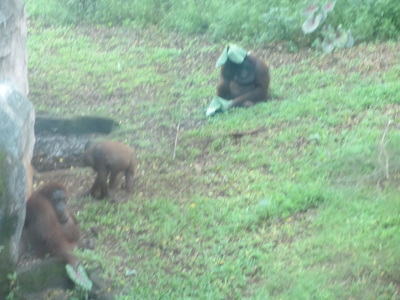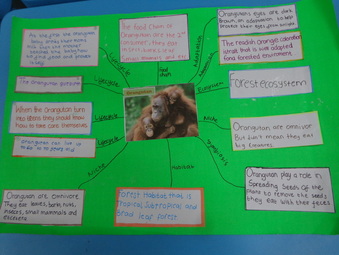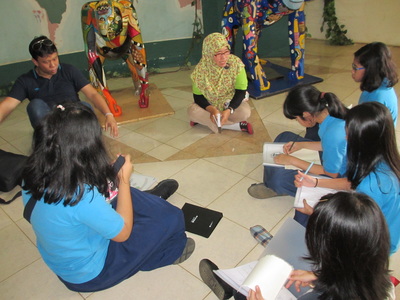Students
Mentors
Central Idea
Biodiversity relies on maintaining the interdependent balance of organisms within system
The Lines of Inquiry
- Ways in which ecosystems, bio mes and environments are interdependent
- How human interaction with the environment can affect the balance of systems
- The consequences of imbalance within ecosystems
SCIENCE STRANDS;
The study of characteristic, systems and behaviors of humans and other animals and of plants interactions and other relationship between and among them with their environment
Exhibition goals;
How orangutan habitat supposed to be and what will happen to the future of orangutan and the solution to save orangutan.
Skills
Social, communication and self management
Attitude
Commitment and cooperation
Step 1; Observe carefully in order to get data
What matters to me when i look at the descriptor of the trans - disciplinary theme
Sharing The Planet
an inquiry into rights and responsibility struggle to share finite resources with other people and other living things; communities and relationship within between them
The study of characteristic, systems and behaviors of humans and other animals and of plants interactions and other relationship between and among them with their environment
Exhibition goals;
How orangutan habitat supposed to be and what will happen to the future of orangutan and the solution to save orangutan.
Skills
Social, communication and self management
Attitude
Commitment and cooperation
Step 1; Observe carefully in order to get data
What matters to me when i look at the descriptor of the trans - disciplinary theme
Sharing The Planet
an inquiry into rights and responsibility struggle to share finite resources with other people and other living things; communities and relationship within between them
1. Exploring, wondering, and questioning
Why orangutan ????
WE WANT TO STOP THEM FOR BEING EXTINCT !!!!!!
"At one time orang-utans ranged throughout much of Asia, from Java in the south, up into southern China. Today they are found only on the islands of Borneo and Sumatra."
Within Borneo their range is limited to remote forests and protected areas and they are absent from large areas of the island.
Bornean orang-utan facts:
Why orangutan ????
WE WANT TO STOP THEM FOR BEING EXTINCT !!!!!!
"At one time orang-utans ranged throughout much of Asia, from Java in the south, up into southern China. Today they are found only on the islands of Borneo and Sumatra."
Within Borneo their range is limited to remote forests and protected areas and they are absent from large areas of the island.
Bornean orang-utan facts:
- The orang-utan is Asia’s only great ape
- Fruit makes up the bulk of an orang-utan’s diet, however other items include leaves, flowers, pith, fungi, honey, termites, small mammals and birds’ eggs
- Adult orang-utans are largely solitary
- The bond between a mother orang-utan and her young is very stron
- Orang-utans face a multitude of threats ranging from loss of habitat as forest is converted for agriculture to hunting and fires.The largest Bornean orang-utan population is now found in the south-western part of Borneo.However, a recent wave of forest conversion, illegal logging and wildlife poaching and the growing threat of palm oil plantations is putting even more pressure on the orang-utan’s survival.
2. Researching and seeking information
10 amazing orangutan facts you need to know :
1. Orangutans are semi-solitary in the wild (unlike other higher primates). Once they reach maturity, they spend most of their time alone, or, in the case of females, with their immature offspring. Adult males old enough to have cheekpads are the most solitary, spending over 90 per cent of their time alone.
2. Orangutans live on only two islands, Borneo and northern Sumatra. They are a relic species. At the end of the Pleistocene period some 12,000 years ago, their range was much wider, encompassing southern China, Indochina, Java and southern Sumatra. The species is now extinct in all these regions.
3. Orangutans are the largest tree-dwelling animals on Earth. Though adult male gorillas climb up to the canopy to feed, they do not spend much time there and are basically terrestrial. Adult male orangutans, reaching a weight of 140kg or more, spend over 90 per cent of their time in the treetops, eating ripe fruit, young leaves and the occassional termite or vine. Adult females spend even more time in the canopy.
4. Adult male orangutans develop cheekpads, which frame their faces and make their heads look larger. In captivity, males as young as 13 develop cheekpads, but in the wild, some males may not grow them until the age of 30. Once a male has his cheekpads, he won't tolerate any other adult males in his vicinity and competes with them for access to receptive females. Cheekpads may also serve an acoustic function in helping project the 'long call' a male uses to broadcast his presence through the dense forest.
5. Orangutans are among the most sexually dimorphic of primates. An adult male may be three times heavier than an adult female. He also sports large cheekpads, a throat pouch that acts as a resonating chamber for his loud call, and a muscular body from a testosterone surge at an earlier stage of life. Males use their large size to compete with each other for access to receptive females.
6. Orangutans have the most intense relationship between mother and young of any non-human mammal. Mothers carry their offspring for the first five years, and may suckle them for six or seven years. For the first eight years of a young orangutans life, its mother is its constant companion. Until another infant is born, mothers sleep in a nest with their offspring every night.
7. Orangutans have the longest birth interval of any mammal. In Borneo, they give birth on average once every eight years. In Sumatra, some females may only give birth once every 10 years. Females often do not breed until the age of 17. If adult females are killed, the population takes a long time to recover.
8. Orangutans are the only great apes of Asia. It appears that they are of African origin but dispersed about 15 million years ago. During the Miocene period, there were many ape species throughout Africa, Asia and Europe. Chimpanzees, bonobos and gorillas survived in Africa, but only the orangutans survived in Asia.
9. Orangutans are gentle and sit for hours gazing. Though males can be aggressive, I have followed orangutans for 36 years and have never been attacked or even chased.
10. Orangutans are very smart. They perform as well as chimpanzees and gorillas in tests of cognitive ability. In captivity, they are excellent tool-users and versatile tool-makers. One captive orangutan was taught how to chip a stone hand-axe. In the wild, one population makes and uses tools for opening and extracting fruit in a sophisticated manner reminiscent of chimpanzees – except that these orangutans hold the tools in their mouths.
10 amazing orangutan facts you need to know :
1. Orangutans are semi-solitary in the wild (unlike other higher primates). Once they reach maturity, they spend most of their time alone, or, in the case of females, with their immature offspring. Adult males old enough to have cheekpads are the most solitary, spending over 90 per cent of their time alone.
2. Orangutans live on only two islands, Borneo and northern Sumatra. They are a relic species. At the end of the Pleistocene period some 12,000 years ago, their range was much wider, encompassing southern China, Indochina, Java and southern Sumatra. The species is now extinct in all these regions.
3. Orangutans are the largest tree-dwelling animals on Earth. Though adult male gorillas climb up to the canopy to feed, they do not spend much time there and are basically terrestrial. Adult male orangutans, reaching a weight of 140kg or more, spend over 90 per cent of their time in the treetops, eating ripe fruit, young leaves and the occassional termite or vine. Adult females spend even more time in the canopy.
4. Adult male orangutans develop cheekpads, which frame their faces and make their heads look larger. In captivity, males as young as 13 develop cheekpads, but in the wild, some males may not grow them until the age of 30. Once a male has his cheekpads, he won't tolerate any other adult males in his vicinity and competes with them for access to receptive females. Cheekpads may also serve an acoustic function in helping project the 'long call' a male uses to broadcast his presence through the dense forest.
5. Orangutans are among the most sexually dimorphic of primates. An adult male may be three times heavier than an adult female. He also sports large cheekpads, a throat pouch that acts as a resonating chamber for his loud call, and a muscular body from a testosterone surge at an earlier stage of life. Males use their large size to compete with each other for access to receptive females.
6. Orangutans have the most intense relationship between mother and young of any non-human mammal. Mothers carry their offspring for the first five years, and may suckle them for six or seven years. For the first eight years of a young orangutans life, its mother is its constant companion. Until another infant is born, mothers sleep in a nest with their offspring every night.
7. Orangutans have the longest birth interval of any mammal. In Borneo, they give birth on average once every eight years. In Sumatra, some females may only give birth once every 10 years. Females often do not breed until the age of 17. If adult females are killed, the population takes a long time to recover.
8. Orangutans are the only great apes of Asia. It appears that they are of African origin but dispersed about 15 million years ago. During the Miocene period, there were many ape species throughout Africa, Asia and Europe. Chimpanzees, bonobos and gorillas survived in Africa, but only the orangutans survived in Asia.
9. Orangutans are gentle and sit for hours gazing. Though males can be aggressive, I have followed orangutans for 36 years and have never been attacked or even chased.
10. Orangutans are very smart. They perform as well as chimpanzees and gorillas in tests of cognitive ability. In captivity, they are excellent tool-users and versatile tool-makers. One captive orangutan was taught how to chip a stone hand-axe. In the wild, one population makes and uses tools for opening and extracting fruit in a sophisticated manner reminiscent of chimpanzees – except that these orangutans hold the tools in their mouths.
3. Collecting data and reporting findings
5 THINGS EVEN THE EXPERTS DON'T KNOW ABOUT ORANGUTANS
1. Why are orangutans orange?
Orangutans 'blaze' in the sunlight but virtually disappear when they move into shadow. In the shade of the canopy, their tan skin absorbs the light so you don't see the sparse hair but the dark skin underneath. Then they become functionally black. Could this now-you-see-me-now-you-don't combination be adaptive? Or, given that they generally don't congregate in groups, does their bright orange colour announce their presence to others of their species? We simply don't know.
2. How long do orangutans live in the wild?
We can only make educated guesses. In captive environments, orangutans have lived for over 60 years. Wild females at my study site who were adolescents back in 1971 are still alive today and bearing offspring. A formerly captive female in her 40s recently had an infant. My guess is that wild orangutans may live into their 70s, but I believe this is rare.
3. How far do orangutan males travel in their lifetime?
They travel greater distances than females. I suspect they may wander hundreds of kilometres away from their mothers' home ranges. In the space of one year, one adolescent male travelled a distance of more than 30km as the crow flies.
4. Were orangutans ever more gregarious than they are now?
This is possible. Ex-captive individuals associated with rehabilitation programmes tend to be more gregarious than wild orangutans. If wild populations lived in fertile lowland areas with abundant concentrations of food, they might have been more gregarious. Since humans have destroyed such forests to use the land for agriculture, sociable orangutans, if they ever existed, are long gone.
5. Will they escape extinction?
The massive destruction of the orangutans habitat – the tropical rain forests of Borneo and Sumatra – is catastrophic. We are working to save the species and its habitat, but the forces arrayed against the orangutan are so formiddable that perhaps, if we (and they) are lucky, just one or two populations may survive.
WHAT WE HAVE DONE SO FAR:
We had a visit to Smutzer in Ragunan to experience the learning process related to this exhibition. There, students observed the life and habitat of Orangutan and interviewed people who work there and took care of them. People who worked with them were very connected with Orangutan, they treated them like humans and what made us surprised was that those orangutan treat them nicely too ( or we can say that orangutan treated them like another orangutan too...hahahahah ) Students were able to absorb the knowledge and grasp the meaning from the visit by presenting their experience through the writing, presenting and drawing in their class. They also arranged and performed various questioners and creating display about orangutan to be used as information later in the exhibition.
5 THINGS EVEN THE EXPERTS DON'T KNOW ABOUT ORANGUTANS
1. Why are orangutans orange?
Orangutans 'blaze' in the sunlight but virtually disappear when they move into shadow. In the shade of the canopy, their tan skin absorbs the light so you don't see the sparse hair but the dark skin underneath. Then they become functionally black. Could this now-you-see-me-now-you-don't combination be adaptive? Or, given that they generally don't congregate in groups, does their bright orange colour announce their presence to others of their species? We simply don't know.
2. How long do orangutans live in the wild?
We can only make educated guesses. In captive environments, orangutans have lived for over 60 years. Wild females at my study site who were adolescents back in 1971 are still alive today and bearing offspring. A formerly captive female in her 40s recently had an infant. My guess is that wild orangutans may live into their 70s, but I believe this is rare.
3. How far do orangutan males travel in their lifetime?
They travel greater distances than females. I suspect they may wander hundreds of kilometres away from their mothers' home ranges. In the space of one year, one adolescent male travelled a distance of more than 30km as the crow flies.
4. Were orangutans ever more gregarious than they are now?
This is possible. Ex-captive individuals associated with rehabilitation programmes tend to be more gregarious than wild orangutans. If wild populations lived in fertile lowland areas with abundant concentrations of food, they might have been more gregarious. Since humans have destroyed such forests to use the land for agriculture, sociable orangutans, if they ever existed, are long gone.
5. Will they escape extinction?
The massive destruction of the orangutans habitat – the tropical rain forests of Borneo and Sumatra – is catastrophic. We are working to save the species and its habitat, but the forces arrayed against the orangutan are so formiddable that perhaps, if we (and they) are lucky, just one or two populations may survive.
WHAT WE HAVE DONE SO FAR:
We had a visit to Smutzer in Ragunan to experience the learning process related to this exhibition. There, students observed the life and habitat of Orangutan and interviewed people who work there and took care of them. People who worked with them were very connected with Orangutan, they treated them like humans and what made us surprised was that those orangutan treat them nicely too ( or we can say that orangutan treated them like another orangutan too...hahahahah ) Students were able to absorb the knowledge and grasp the meaning from the visit by presenting their experience through the writing, presenting and drawing in their class. They also arranged and performed various questioners and creating display about orangutan to be used as information later in the exhibition.
|
All the species that share the rain forest have a part to play in the health of the ecosystem, but orangutans are sometimes referred to as ‘gardeners of the forest’. They eat hundreds of different types of fruit, and spread the seeds throughout the forest in their dung. They also make a new nest to sleep in every evening, breaking branches and allowing light through the thick canopy onto the forest floor, helping young plants to thrive and grow.
|
|
5. Experimenting and playing with possibilities
We make an experiment to prove how the orangutan can help in spreading the seeds in the forest. We spread the seeds on the different tray. First tray we spread the seeds with orangutan's enzyme, second tray the seeds without enzyme and the third tray with human's enzyme.
Day 4
- The seeds with human's enzyme have grown a little they showed signs of green on top pf the soil
- The seeds without enzyme grew a little bit
- The seeds with orangutan's enzyme have also grown a little bit higher than others
6. Taking and defending a position
CAMPAIGNING AND EDUCATE PEOPLE AT THE RAGUNAN ZOO
CAMPAIGNING AND EDUCATE PEOPLE AT THE RAGUNAN ZOO





















